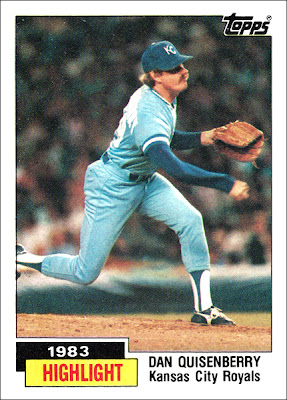Vital Statistics
Topps in '84 holds to what had become the decade-standard formulation of a 792-card base set and a 132-card Traded set.
New to the Dodgers in the 1984 set was trade deadline acquisition Rick Honeycutt, for whom LA had sent Dave Stewart to the Texas Rangers in mid-August of '83. Honeycutt's 2.42 ERA at the time of the deal would stand up as the American League's best for the season. Unfortunately, he would manage just a 2-3 record with a 5.77 ERA down the stretch, and was rocked for four runs in two brief relief appearances in LA's NLCS loss to Philadelphia's "Wheeze Kids." Apparently, Topps was able to capture one back-lit shot of the lefty late in the season, but couldn't be bothered to snap the shutter twice, as evidenced by the airbrush job on the smaller photo. Honeycutt would later be reinvented by Tony LaRussa and Dave Duncan as a key piece of the bullpen for the Oakland A's late-80s mini-dynasty. Today, of course, he is the Dodgers' pitching coach, which has to be among the best coaching gigs in the bigs.
Special Cards
Checklists
Not bad. Nice box in the bottom left with a baseball under the text "1984 Baseball Checklist." Bright green backgrounds with little yellow check boxes. Inoffensive for their type.
Managers
After their return in 1983, managers continue a long stretch of rightful inclusion. Team logos take the place of the secondary photo, which is a nice touch. The backs again feature playing and managerial records. It's always good to see the skippers receive the dignity that they deserve.
Season Highlights
Cards #1-6. Back to highlights rather than Record Breakers, with predictably positive results. This subset is made a little more interesting than usual by its division into two groups of three cards. The first three feature individual players, including a couple of perennial highlight subjects. Steve Carlton is saluted for winning his 300th game and jockeying with Nolan Ryan for the top position (temporarily) on the all-time strikeout list. And Rickey Henderson gets a nod for his third straight 100-steal season. Dan Quisenberry receives this card (#3) for being one in a long line of closers over the past few decades to establish a new single-season saves mark (39, for the record). One flaw of these cards is that they don't explain the highlight on the front of the card. That keeps the design uncluttered, but it's not the most inspired design to begin with. The next three cards in the subset each feature three players, and take some space to explain themselves on the front. One has the authors of the three no-hitters thrown in 1983, Dave Righetti, Bob Forsch and Mike Warren. Then Carlton gets more recognition for surpassing Walter Johnson at the top of the strikeouts list, along with Ryan and Gaylord Perry. We will see the final card in this series later.
All-Stars
Cards #386-407. Topps comes up with another nice design for its All-Star cards. You really should feature stars as design elements for these, and Topps doesn't disappoint. They actually deviate very little from the base card design, as the all-star designation replacing the inset portrait is the only difference. The backs are excellent, sharing "Personal Data" about the players. We got to find out that Mike Schmidt enjoys electric train sets, Steve Rogers is partial to Indian arrowheads, Jesse Orosco paints and sculpts, Ted Simmons likes to go antiquing, and Cary Carter collects baseball cards! We were also informed of each player's marital status. Cal Ripken is single, ladies!
Team Leaders
For the third year in a row, team checklists come in the form of Team Leader cards. Not much to say about these except that the photo cropping is generally better than it had been the previous year.
League Leaders
Cards #131-138. The photos are also improved from a year ago on the League Leaders cards. I'm beginning to suspect that with the more intricate design and additional photo to deal with, Topps was a bit rushed toward the end in 1983 and the subsets suffered a bit for it. They were a little more on top of their game with these in '84. Though I can't say I love the design choice for the boxes indicating NL and AL, its a pretty good-looking subset. I particularly like the Batting Leaders card (#131) because it represents a kind of changing of the guard, featuring Bill Madlock's last of four batting titles and the first of five for Wade Boggs.
Active Career Leaders
Cards #701-718. As you can imagine, I love these. In fact, I may love them as much as 1983's Super Veterans. They provide an opportunity to feature not only future Hall-of-Famers, but to recognize the excellence of other great veterans nearing the end of their playing days, like Bert Campaneris, Ted Simmons and Jerry Koosman. The longtime Mets' lefty counterpart to Tom Seaver is seen here (#716) with a pair of Cooperstown inductees in this set ripe with celebrations of strikeout artists. The backs of these cards show a list not only of the league's active leaders, but also the all-time career leaders, making this a perfect concept for placing (then) current stars within a historical context. And that's one of the greatest things to appreciate about the game of baseball. I'm just glad they got this idea in before the friggin' steroid era.










No comments:
Post a Comment